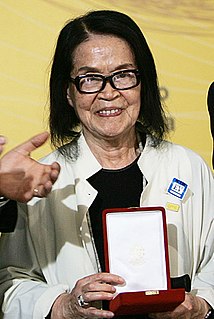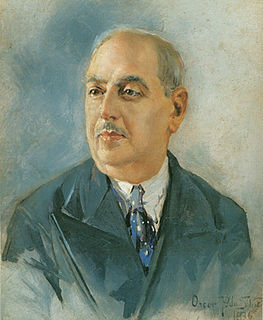Related Research Articles

Tarsila de Aguiar do Amaral was a Brazilian painter, draftswoman, and translator. She is considered one of the leading Latin American modernist artists, and is regarded as the painter who best achieved Brazilian aspirations for nationalistic expression in a modern style. As a member of the Grupo dos Cinco, Tarsila is also considered a major influence in the modern art movement in Brazil, alongside Anita Malfatti, Menotti Del Picchia, Mário de Andrade, and Oswald de Andrade. She was instrumental in the formation of the aesthetic movement, Antropofagia (1928–1929); in fact, Tarsila was the one with her celebrated painting, Abaporu, who inspired Oswald de Andrade's famous Manifesto Antropófago.

Ismael Nery was a Brazilian artist.

Abraham Palatnik was a Brazilian abstract artist and inventor whose innovations include kinechromatic art.

Hélio Oiticica was a Brazilian visual artist, sculptor, painter, performance artist, and theorist, best known for his participation in the Neo-Concrete Movement, for his innovative use of color, and for what he later termed "environmental art", which included Parangolés and Penetrables, like the famous Tropicália. Oiticica was also a filmmaker and writer.

Gretta Alegre Sarfaty also known as Gretta Grzywacz and Greta Sarfaty Marchant, is a painter, photographer and multimedia artist who earned international acclaim in the 1970s, from her artistic works related to Body art and Feminism. Born in Greece, she moved with her family to São Paulo in 1954. From 1976 she lives and works in London, São Paulo and New York. Alongside her art she was the founder of the project-led space, Sartorial Contemporary Art (2005–2010) and since 2010 has been running a family trust the Alegre Sarfaty Collection.
Alfredo Da Silva was a painter, graphic artist, and photographer, known for his abstract expressionism. He came to international prominence in 1959 and remained so until his death in 2020.

Tomie Ohtake was a Japanese Brazilian visual artist. Her work includes paintings, prints and sculptures. She was one of the main representatives of informal abstractionism in Brazil.

Sergio Valle Duarte (born September 26, 1954), also known as Sergio Duarte, is a Brazilian multimedia artist and fine-art photographer.
Iole Antunes de Freitas is a Brazilian sculptor, engraver, and installation artist who works in the field of contemporary art. Freitas began her career in the 1970s, participating in a group of artists in Milan, Italy linked to Body art. She used photography. In the 1980s, she returned to Brazil, but abandoned the human body as mediator of her work, adopting the "sculpture body". The artist uses materials such as wire, canvas, steel, copper, stone, and water to create her works.
María Freire was a Uruguayan painter, sculptor, and art critic. She was one of the leading figures in the development of concrete art and non-figurative art in Uruguay. She was a co-founder the Grupo de Arte No Figurativo.

Willys de Castro was a Brazilian visual artist, poet, graphic designer, industrial designer, stage designer and magazine editor. De Castro is best known for his "Active object" series and is considered to be a pioneer and founding contributor of the Neo-Concrete Movement.

Ivan Ferreira Serpa was a Brazilian painter, draftsman, printmaker, designer, and educator active in the concrete art movement. Much of his work was in geometric abstractionism. He founded Grupo Frente, which included fellow artists Lygia Clark, Helio Oiticica, and Franz Weissmann, among others, and was known for mentoring many artists in Brazil.
Hermelindo Fiaminghi was a Brazilian painter, designer, graphic designer, lithographer, professor, and art critic, known for his geometric works and exploration of color.
Geraldo de Barros was a Brazilian painter and photographer who also worked in engraving, graphic arts, and industrial design. He was a leader of the concrete art movement in Brazil, co-founding Grupo Ruptura and was known for his trailblazing work in experimental abstract photography and modernism. According to The Guardian, De Barros was "one of the most influential Brazilian artists of the 20th century." De Barros is best known for his Fotoformas (1946-1952), a series of photographs that used multiple exposures, rotated images, and abstracted forms to capture a phenomenological experience of Brazil's exponential urbanization in the mid-twentieth century.
Amelia Amorim Toledo was a Brazilian sculptor, painter, draftsman and designer. With a career that expanded over fifty years, Toledo explored multiple artistic languages, techniques, materials, and production methods. She is considered to be one of the pioneers of Brazilian contemporary art.
Anna Letycia Quadros was a Brazilian artist and educator.

Edith Behring was a Brazilian artist and educator.

Yolanda Léderer Mohalyi was a painter and designer who worked with woodcuts, mosaics, stained glass and murals as well as more usual materials. Her early work was figurative, but she increasingly moved towards abstract expressionism. With artists such as Waldemar da Costa and Cicero Dias, she opened the way for abstraction in Latin American art.

Oscar Pereira da Silva was a Brazilian painter, draftsman, designer, and instructor. He was active from the end of the 19th to the mid-20th century. He is noted for his depictions of historical events in Brazil, but also completed numerous portraits, religious works, genre scenes, still lifes, and landscapes. He "paid no attention to Brazilian folk tradition" and painted in an "antique style." After a period of study in France, he pursued a lucrative career in São Paulo, where his works are displayed at the Pinacoteca do Estado de São Paulo and the Museu do Ipiranga.

Flavio-Shiró is a Japanese-Brazilian visual artist. Regarded as an influential postwar Brazilian painter, he is known for his dark and disturbing paintings that merge elements of abstract expressionism and surrealism. He is one of the main representatives of abstract expressionism in Brazil.
References
- 1 2 "Teresa Nicolao". Enciclopédia Itaú Cultural de Arte e Cultura Brasileiras (in Portuguese).
- 1 2 "Nicolao, Tereza". Brasil Artes Enciclopédias (in Portuguese).
- ↑ "Nicolao, Teresa (1928)". Catálogo das Artes (in Portuguese).